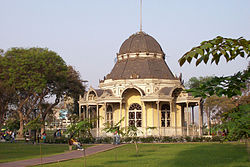|
Parque de la Exposición
The Park of the Exhibition (Spanish: Parque de la Exposición), known between 1999 and 2004 as the Grand Park of Lima (Spanish: Gran Parque de Lima),[1] is a park located in the neighbourhood of Santa Beatriz, itself part of the buffer zone of the historic centre of Lima, Peru. It was built to replace the city's walls, demolished as part of a citywide renovation project in order to host an international exhibition in 1872. History The park was occupied by the south gate of the Walls of Lima, known as Puerta de Guadalupe. In the 1870s President José Balta ordered the demolition of these walls within its modernisation plan of the city. It was planned that this location would be aimed at building a park that would house the Lima International Exhibition of 1872.[2] Thus, alongside the park, rose the Palacio de la Exposición (now the Lima Art Museum). The park plan was made by Manuel Atanasio Fuentes and Italian architect Antonio Leonardi. Its design was neo-Renaissance and included the construction of pavilions including a zoo and other buildings. Leonardi also designed the Palacio de la Exposición. In the beginning the largest, covering the current and contemporary Park of the Reserve and the land where now stands the Estadio Nacional, were part of the park. Zoo Among the park's features was a zoo, whose animals (and plants) were brought from the Peruvian Amazon by an expedition headed by Henrique Casseu in 1871. The expo's catalog lists a total of 271 different species of animals. In addition to this collection, donations were also made, such as that of Peruvian minister in Brazil Luis Mesones, who donated two tigers that arrived via boat.[3] After the exhibition ended, the part of the zoo that faced the (now demolished) square of the same name remained. With the construction of the Paseo Colón in 1899, a new entrance was built. It was completely destroyed during the War of the Pacific by the Chilean Army as part of its occupation of the city, with some animals killed and others stolen by the invading army, as was the case of the lions taken to Santiago Zoo.[3] After the war, the zoo was reestablished through donations from locals and eventual foreign acquisitions, existing until its decay in the early 20th century, caused by poor hygiene conditions and improper care of the animals, the growth of the city, and the worldwide crisis. In 1935, on the city's 400th anniversary, mayor Luis Gallo Porras ordered that the zoo be moved to Barranco District, which was not done until 1944.[3] This new zoo closed in 1970, replaced by the Parque de las Leyendas.[4] Post-ExhibitionDuring the War of the Pacific, the park housed a garrison and a hospital prior to the occupation, later serving as a headquarters for the Chilean troops. With the celebration of the centennial of the independence of Peru, Augusto B. Leguía ordered the construction of several additional buildings, such as the Byzantine Hall and the building that served as headquarters of the Ministry of Development and Public Works, which currently houses the Metropolitan Museum of Lima since 2010.[5] In 1961 the demolition of the so-called Panopticon was ordered,[6] to be replaced by the Civic Centre construction project.[7] The land north of the park, currently home to the Centre for Military and Historical Studies and the Museum of Italian Art, originally belonged to the park itself. During the 1970s, the park fell into a severe decline. In the 1990s, during the administration of Alberto Andrade, it was restored and lakes and an amphitheatre were created and the park opened to the park. Andrade renamed the park calling it the Grand Park of Lima (Spanish: Gran Parque de Lima) but it later returned to its original name. Landmarks
See alsoReferences
|
||||||||||||||||||||||||||||||||||||||||||||||||||||||||||||||||||
Portal di Ensiklopedia Dunia















